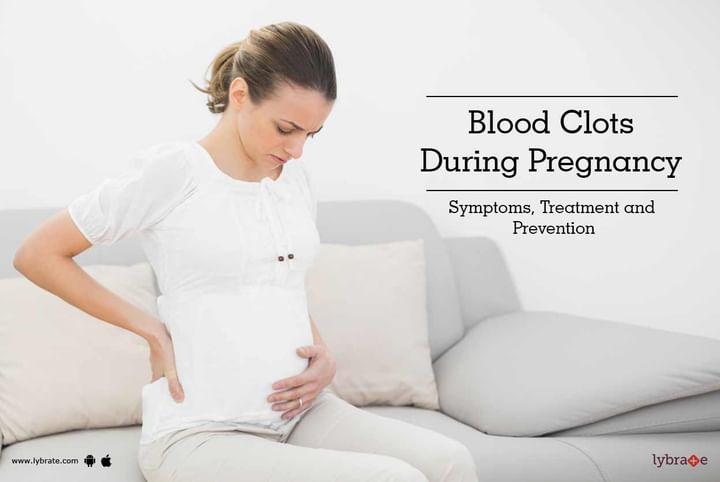Blood Clots During Pregnancy - Symptoms, Treatment and Prevention
A blood clot (also called a thrombosis) is a mass or clump of blood that forms when blood changes from a liquid to a solid. The body normally makes blood clots to stop the bleeding after a scrape or cut. But sometimes blood clots can partly or completely block the flow of blood in a blood vessel, like a vein or artery. This can cause damage to body organs and even death.
Blood Clots Problems during Pregnancy Periods
Most women with blood clotting conditions have healthy pregnancies. But these conditions may cause problems for some pregnant women. In severe cases, they can cause death for both mom and baby. But testing and treatment can help save both you and your baby.
If you’re pregnant or trying to get pregnant and have had problems with blood clots in the past, tell your health care provider at a preconception checkup (before pregnancy) or at your first prenatal care checkup. Also, tell your provider if someone in your family (your parent or a brother or sister) has had problems with blood clots. This means the condition may run in your family.
Cause of blood clots during pregnancy?
If you have a blood clot or a kind of thrombophilia called antiphospholipid syndrome (also called APS), you may be more likely to have complications that can affect your health and your baby’s health, including:
- Blood clots in the placenta. The placenta grows in your uterus (womb) and supplies the baby with food and oxygen through the umbilical cord. A blood clot in the placenta can stop blood flow to your baby and harm your baby.
- Heart attack. This usually happens when a blood clot blocks blood and oxygen flow to the heart. Without blood and oxygen, the heart can’t pump blood well, and the affected heart muscle can die. A heart attack can lead to lasting heart damage or death.
- Intrauterine growth restriction (also called IUGR). This is when your baby grows poorly in the womb.
- Miscarriage. A miscarriage is when a baby dies in the womb before 20 weeks of pregnancy.
- Placental insufficiency. This is when the placenta doesn’t work as well as it should so your baby gets less food and oxygen.
- Preeclampsia. Preeclampsia is a condition that can happen after the 20th week of pregnancy or right after pregnancy. It’s when a pregnant woman has high blood pressure and signs that some of her organs, like her kidneys and liver, may not be working properly. Some of these signs include having protein in the urine, changes in vision, and severe headache.
- Premature birth. This is when your baby is born before 37 weeks of pregnancy.
- Pulmonary embolism (also called PE). An embolism is a blood clot that moves from where it formed to another place in the body. When the clot moves to a lung, it’s a PE. PE can cause low oxygen levels in your blood and damage your body organs. It’s an emergency and a leading cause of death during pregnancy. Signs and symptoms of PE may include:
- Trouble breathing
- Fast or irregular heartbeat
- Chest pain
- Fainting
- Feeling anxious
- Coughing up blood
- Stillbirth. This is when a baby dies in the womb after 20 weeks of pregnancy.
- Stroke. This happens when a blood clot blocks a blood vessel that brings blood to the brain, or when a blood vessel in the brain bursts open. Pregnancy and childbirth cause strokes in about 8 in 100,000 women. Stroke can cause lasting damage to the body or death.
- Thrombosis. This happens when a blood clot forms in a blood vessel and blocks blood flow. It most often happens in the deep veins of the legs but can be in other places of the body:
How to treat blood clots condition during pregnancy?
Your provider may use tests like ultrasound or magnetic resonance imaging (also called MRI) to find out if you have a blot clot or clotting conditions in yoursbody. Ultrasound uses sound waves and a computer screen to show a picture of your baby inside the womb. MRI is a medical test that makes a detailed picture of the inside of your body. These tests are painless and safe for you and your baby.
If you are pregnant and have a blood clotting condition, you may need to go for prenatal care checkups more often than women who don’t have these blood clot conditions. At these visits, your provider checks your blood pressure and can use other tests, like blood tests, to monitor your health.
Your gynecologist also checks your baby’s health in the womb using tests like:
- Ultrasound to check your baby’s growth and development. She may use a special kind of ultrasound called Doppler to check your baby’s blood flow in the umbilical artery, a blood vessel in the umbilical cord. The umbilical cord connects your baby to the placenta. It carries food and oxygen from the placenta to the baby.
- Fetal heart rate monitoring (also called a nonstress test or NST). This test checks your baby’s heart rate in the womb and sees how the heart rate changes when your baby moves. Your provider uses this test to make sure your baby’s getting enough oxygen.
A blood clot condition occurs when your body sends cells, called platelets, to interrupt the stream of blood. Typically, this happens when you have a cut, to keep the damage from draining consistently. During pregnancy, your blood will probably cluster as a defense mechanism against losing an excessive amount of blood during the process.
Signs and Symptoms of Blood Clots During Pregnancy
Women have a tendency to be more sensitive and risk-prone of potential difficulties while they are pregnant. Despite the fact that blood clots are far-fetched, there are a couple of signs that can demonstrate the possibility of a blood clot. These include:
- Swelling or pain in one leg
- Pain that increases when you walk
- Veins that look bigger or more swollen than usual
Different components that can additionally raise your odds of growing profound vein related blood clots in pregnancy include:
- Being thirty-five or older while pregnant
- Pre-pregnancy blood clots outside of pregnancy
- Being overweight
- Smoking
- Having a cesarean conveyance (C-section).
However, there are certain solutions to every problem. In order to get rid of blood clots during pregnancy or prevent them from happening, these are the possible solutions:
- Continue moving: In case that you are overweight and inactive, it will affect your blood-stream and increase your risk for profound vein clots in pregnancy. So, remain active and keep up a healthy weight. If you must be on bed rest because of damage or inconvenience in your pregnancy, your specialist may endorse blood thinners as a careful step.
- Get up during travel: Flying alone is a risk for clots; so pregnant women need to be very careful about that. In case you need to fly, get up and move around consistently and do a lower leg exercise while you sit. Do a similar thing in case you go for a long journey or have to travel fast.
- Wear pressure tights: Since they enhance the flow and lessen swelling in the legs, pressure tights can bring down your danger of profound clots in pregnancy.
- Drink loads of water: Remaining hydrated during pregnancy forestalls clots by keeping the blood from getting too thick.
The reason pregnant women need to be aware of the connection between pregnancy and clot risks is that an untreated clot can possibly break free and go through the circulatory system. The fear is that it will move to the heart or lungs and cause a pneumonic embolism, which can lead to death. If you wish to discuss any specific problem, you can consult a gynecologist.
Update From Lybrate: Just like the face, we need to take care of our intimate areas too. Buy Intimate Hygiene Care Products from Lybrate and keep yourself healthy and infection-free.
In case you have a concern or query regarding gynaecological issues, you can consult a gynaecologist online & get the answers to your questions through online doctor consultation via video call.



+1.svg)
